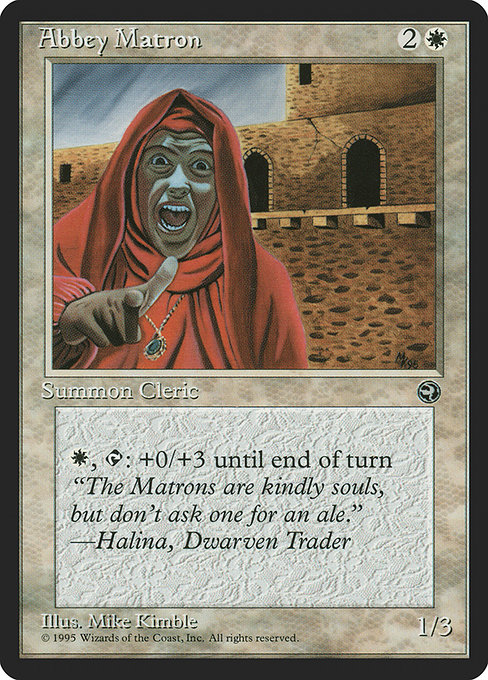
Image courtesy of Scryfall.com
Abbey Matron and the Evolution of Temporary Buffs in MTG
If you’ve ever built a white-centric board and asked, “How far can a single creature be pushed by a dedicated buff?”, Abbey Matron from Homelands is a charming, historically telling data point 🧙♂️. Released on a brisk fall day in 1995, this common Human Cleric carries a simple but telling line: “{W}, {T}: This creature gets +0/+3 until end of turn.” It’s a tiny design, but it points to a broader arc in Magic: The Gathering—how players gained access to short-lived power boosts and how those boosts evolved across the decades. The card’s 2 generic and white mana cost (CMC 3) in a 1/3 body represents the era’s preference for solid, self-contained tempo plays that didn’t require fragile setup or fragile timing. In today’s meta, that one-line text would feel quaint, but it’s a beacon of how temporary power, self-timely, and activation costs began shaping the tempo game in MTG 🧩.
Why did this mechanic catch on? Because early sets like Homelands were exploring how players could interact with the stack, tap phases, and combat damage in meaningful, bite-sized chunks. Abbey Matron’s ability is a classic “temporal buff”—a one-turn surge that can swing a trades scenario, potentially turning a stalemate into a favorable exchange. The effect is narrow, but it’s not trivial: it changes when and how you block, and it creates a small but real decision point each combat step. The flavor text, “The Matrons are kindly souls, but don’t ask one for an ale,” paints a picture of a monastery that has learned to wield quiet, precise power rather than flashy miracles. That restraint—white’s disciplined approach—echoes through the centuries of MTG design 🗝️.
“The Matrons are kindly souls, but don't ask one for an ale.” — Halina, Dwarven Trader
As the years rolled on, MTG designers expanded the repertoire of buffs beyond one-off self-boosts. In the early days, you’d see simple pump spells like Giant Growth or cheaper instants that granted temporary power boosts to creatures, often targeting any creature on the battlefield. The palette widened to include anthem effects that grant global buffs to all your creatures, and pump abilities found their way onto equipment, auras, and even other permanents. Abbey Matron sits at an inflection point: it’s a hand-tuned, creature-centric buff that invites players to think about tempo, timing, and the value of a single activated ability. It’s also the start of a long tradition in white’s toolkit—steady, reliable, and designed to enable aggressive or defensive plays without breaking the bank 🔥.
Move forward through the timeline, and you’ll notice several key shifts in how temporary buffs are engineered. First, the variety of activation costs expanded. You’d see mana-spend costs not limited to a single color, and you’d encounter tap abilities on creatures that could turn the tide in combat. Then comes the era of flexible buffs—abilities that can be applied to multiple targets or wrought via spells and creatures, enabling more complex combat math and synergies with other mechanics like aura-stripping, protection, or even blink effects. The linear, self-contained approach of Abbey Matron gave way to a layered design space where buffs could be conditional, global, or even tied to other keywords like vigilance, menace, or lifelink. The evolution is a story about how players crave agency—being able to choose when to push power, and how to preserve it through careful play 🧠🎲.
Abbey Matron also invites us to consider the art of restraint. In a world full of flashy board-waving effects, a modest pump on a single creature can be the quiet engine behind a successful stall or a surgical tempo play. The white color identity—often aligned with order, protection, and precise answers—finds a natural fit in this kind of design: you invest mana, you tap, and you gain a short-lived edge that must be timed with care. The card’s common rarity and its Homelands era placement remind us that MTG’s design evolution wasn’t just about power spikes; it was about how an accessible mechanic could teach players to read the board, weigh risk, and appreciate the artistry of a measured advantage. And yes, it’s still satisfying to see that little +0/+3 pop when a critical blocker stumbles into place 🛡️.
For fans who love the tactile feel of a well-timed buff, the Abbey Matron lineage hints at a broader narrative about the mechanics we adore in MTG: the blend of cognitive challenge, strategic timing, and a pinch of whimsy. It’s not a grand upheaval, but a testament to how the simplest ideas—pay a cost, grant a temporary boost—can ripple through decades of card design and deck-building philosophy. If you’re exploring a white-leaning throwback or a modern rebuild that channels that needle-threaded tempo, Abbey Matron stands as a friendly reminder that sometimes the most enduring mechanics are the ones that feel almost obvious in hindsight 🧙♂️💎⚔️.
More from our network
- https://blog.zero-static.xyz/blog/post/everything-we-want-to-see-next-in-xenoblade-chronicles-3/
- https://articles.zero-static.xyz/blog/post/master-red-dead-redemption-2-gear-loadouts-for-any-situation/
- https://crypto-acolytes.xyz/blog/post/nft-stats-heavenware-322-from-heavenware-collection/
- https://crypto-acolytes.xyz/blog/post/nft-stats-planet-kaiju-3406-from-planet-kaiju-collection/
- https://blog.rusty-articles.xyz/blog/post/light-gray-stained-glass-pane-mob-proofing-guide/

Abbey Matron
{W}, {T}: This creature gets +0/+3 until end of turn.
ID: 158caa84-da2e-4c4c-b24d-0c035c900e20
Oracle ID: 62e3f285-886c-414e-b4ff-403a7c01c23a
Multiverse IDs: 3011
TCGPlayer ID: 4436
Cardmarket ID: 7814
Colors: W
Color Identity: W
Keywords:
Rarity: Common
Released: 1995-10-01
Artist: Mike Kimble
Frame: 1993
Border: black
EDHRec Rank: 28571
Set: Homelands (hml)
Collector #: 2a
Legalities
- Standard — not_legal
- Future — not_legal
- Historic — not_legal
- Timeless — not_legal
- Gladiator — not_legal
- Pioneer — not_legal
- Modern — not_legal
- Legacy — legal
- Pauper — legal
- Vintage — legal
- Penny — not_legal
- Commander — legal
- Oathbreaker — legal
- Standardbrawl — not_legal
- Brawl — not_legal
- Alchemy — not_legal
- Paupercommander — legal
- Duel — legal
- Oldschool — not_legal
- Premodern — legal
- Predh — legal
Prices
- USD: 0.14
- EUR: 0.10
More from our network
- https://blog.crypto-articles.xyz/blog/post/giratina-coin-flips-and-probability-in-lost-origin-decks/
- https://crypto-acolytes.xyz/blog/post/nft-stats-x58-from-http-status-code-collection-collection/
- https://crypto-acolytes.xyz/blog/post/nft-stats-lil-chiller-1950-from-lil-chillers-collection/
- https://wiki.digital-vault.xyz/wiki/post/pokemon-tcg-stats-zekrom-card-id-bwp-bw05/
- https://crypto-acolytes.xyz/blog/post/nft-stats-gold-bar-749-from-solana-gold-bars-collection/
